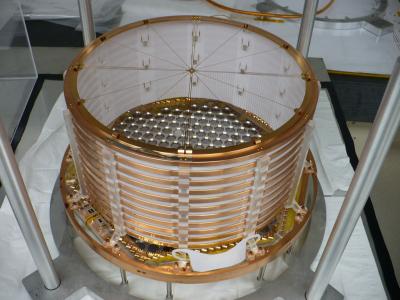In a paper published in Physical Review Letters, Krishna Kumar and Andrea Pocar, physicists from the University of Massachusetts Amherst have described the findings of a test carried out at the Enriched Xenon Observatory (EXO) in a salt mine in Carlsbad, New Mexico, as part of a 10-year old claim to witness the ephemeral neutrino-less double-beta decay of Xenon-136.
 This is half of the innermost detector for EXO-200, a so-called Time Projection Chamber, before it was installed inside the copper cryostat. (credit: UMass Amherst)
This is half of the innermost detector for EXO-200, a so-called Time Projection Chamber, before it was installed inside the copper cryostat. (credit: UMass Amherst)
Although the short-lived nuclear decay is yet to be observed, Kumar, Pocar and a multi-institute team of 60 researchers have achieved a significant progress by successfully setting a new lower limit for the nuclear decay’s half-life using the EXO-200 detector.
Pocar informed that this detector can study half-lives that are 10^15 folds the age of the universe. A new hypothetical elucidation of particle physics may be required to prove the existence of neutrino-less double-beta decay, which may help understand the asymmetry between particle and anti-particle that we see in the universe.
The EXO-200 tests were the first to experimentally observe the standard double beta decay in Xenon-136. In the latest experiments, the researchers tested out the possibility of neutrino-less double-beta decay, which may require new hypothetical explanations. Neutrinos, a fundamental particle without an electric charge, are the only matter that may demonstrate to be its own anti-matter, with finite mass. If it is true, then neutrino-less double-beta decay is also possible. Identifying a matter that is its own anti-matter helps answer the question why the universe we see is made of particle instead of anti-particle.
At the EXO-200 experiment, a five-foot-diameter copper barrel placed inside a clean room is made to function as a cryostat by cooling it with refrigerators. The researchers then placed a bucket-sized detector within the barrel, sealed and filled it with 200 kg of enriched xenon, and cooled it down to −100 °C. Now, Xenon is converted into a liquid with a density three folds more than water. The detector is developed with rigorous cleanliness standards to get the lowest possible environmental radioactivity that may be misguided for double beta decay occurrences.
If neutrinoless double-beta decay of Xenon-136 occurs, the detector will sense the concurrent emission of two electrons by the nucleus with no neutrinos during decay. The mine’s rock and salt protect the detector against majority of the cosmic rays, which may affect the event. A smaller lab at the University of Massachusetts Amherst enables Kumar, Pocar and other researchers and students of the university to probe individual detector components and findings observed at EXO in a local setup.